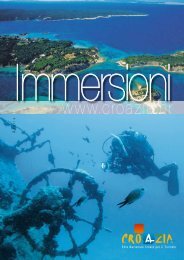Diving
Diving
Diving
Create successful ePaper yourself
Turn your PDF publications into a flip-book with our unique Google optimized e-Paper software.
Along the coast of the island of Drvenik, in front of Grebaštica, is the<br />
entrance to an underwater cave with air cupola (siphon). The second<br />
accessible underwater cave in this area is located on the western cape<br />
of the island Tmara near Primošten, in a wall which extends 200 m<br />
southwards from the cape, towards Primošten. The entrance to the cave<br />
lies at a depth of 35 m; it has a flat, sandy bottom and is home to a host<br />
of lobsters who guard it vigilantly from all those with an inquisitive nature.<br />
A little further north from Tmara is a sunken reef which the local divers call<br />
the Cathedral – due to its two rounded peaks and the varied configuration<br />
of surrounding walls which are particularly interesting on the northern and<br />
southern sides.<br />
Immediately in front of Primošten, lying at a readily accessible depth of<br />
24 to 30 m, are the remains of the Italian cargo ship Mirano, used by the<br />
German Navy to transport coal. In September 1943 it came under heavy<br />
artillery fire from an Allied battery stationed on the nearby mainland. The<br />
vessel caught fire and sank. After the war parts of the wreck were lifted<br />
out (propellers, section of the ship superstructure, engines and other<br />
items) since it was lying in shallow waters on a busy navigational route,<br />
while the side shell, part of the mast, compressed air containers used<br />
to start the engines, and other sections of the deck, still remain on the<br />
sandy seabed. Scattered around the wreck is its cargo – coal – where<br />
lobsters, octopuses, conger eels and many other types of fish have made<br />
their home.<br />
Close to the island of Mala Smokvica there lies the wreck of a small<br />
steamship at a very accessible depth of 20 to 27 m, which makes it a<br />
very frequently visited destination for divers of all categories. Its boilers lie<br />
on the seabed, alongside the ship’s hull, but its port side shell is located<br />
in the immediate vicinity of the southern coast of the island, which tells us<br />
that the ship was badly damaged, that it exploded while sailing, and once<br />
it had lost a section of its hull it went rapidly sank to the sandy bottom<br />
close to the SW cape.<br />
On the seaward side of the island of Velika Smokvica is a wonderful wall<br />
with red gorgonians which extends from 18 to 60 m in depth, its most<br />
beautiful section being from 20 to 35 m. Close to the coast are shards<br />
of ancient pottery, a sure sign of dangers these shores posed (and still<br />
pose) in bad weather conditions. Slightly to the west along the wall, at<br />
a depth of 35 m, lies an 8 m-long torpedo. It is believed to have been<br />
lost during military exercises by the former Yugoslav Army, and when its<br />
explosive charge was rendered useless it was left on the sea bottom.<br />
West of Mala Smokvica, close to a sunken reef, the tip of which is at a<br />
depth of 7 m, along its southern incline and lying at a depth of from 38 to<br />
42 m on the sandy seabed, is a pontoon bridge, its construction being<br />
in the shape of ship’s hull with a wide, covered deck and side posts<br />
along its edges, with some of their tops having become overgrown with<br />
large sponges. West of the pontoon is a well full of holes and crevices,<br />
frequently with lobsters and fish finding shelter within them.<br />
West of cape Ploča is the Mulo lighthouse, a very suitable area for<br />
diving since orientation around the island is simple. On the western side<br />
are cascades that tumble down to a depth of 42 m, while around the<br />
caves at the bottom of the slope it is possible to chance upon common<br />
eagle ray, dogfish, lobsters and other types of fish hiding in the holes<br />
within the walls.<br />
∆ Tree formations of large gorgonian corals<br />
are frequently found on the sea bed of the<br />
central Adriatic Sea<br />
Croatian National Tourist Board<br />
31




